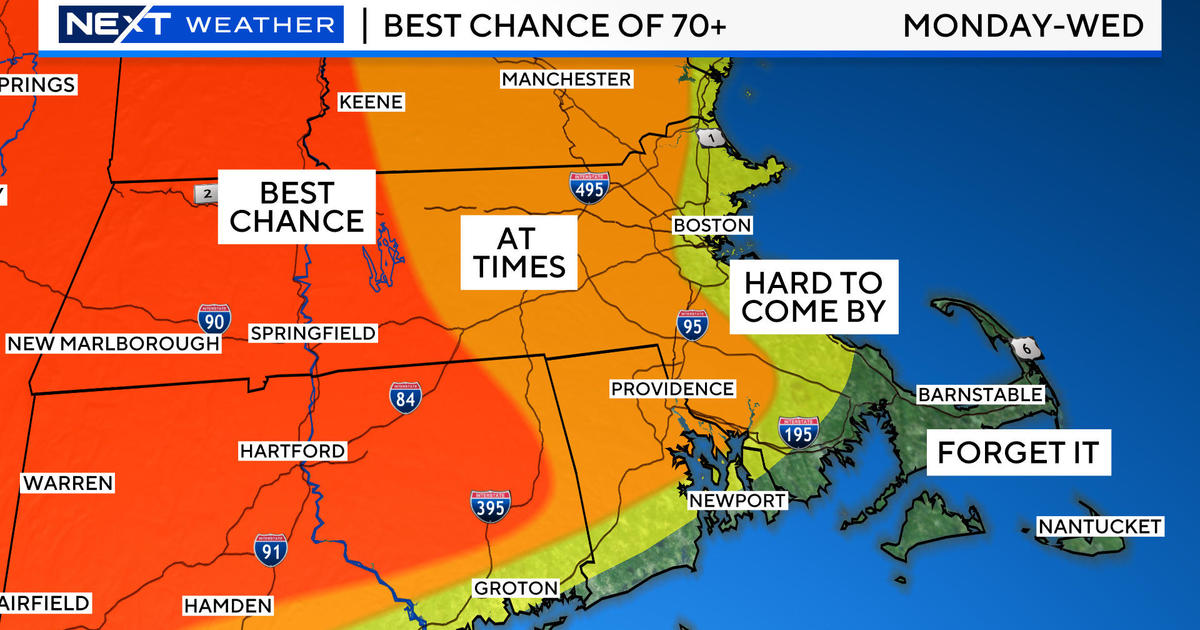Will We Pay For Warm Start To Fall?
BOSTON (CBS) - New Englanders have a firm belief in comeuppance, and in no other situation is this more evident than the weather.
Many a native can be seen looking over their shoulder on a nice day, wondering if a 2-ton snowflake will hit them in the face or tornado will drop out of the blue.
Pleasant days must meet their equal in meteorological pain, right? And so this autumn has been filled with comments on my Twitter feed about how badly we will pay for this influx of solar Vitamin D.
Is there any science behind that?

The start of October has been extremely warm east of the Rockies and it looks like this trend will continue
In short, no. A pleasant and enjoyable fall does not necessarily mean the arctic hammer will fall in winter.
In fact, it is often just the opposite.
I wanted to take a look back through some of our warmest apple picking seasons and see what transpired in the months that followed. If you're wondering where we currently stand, we're on pace for a Top 3 warmest fall across much of New England to this point. I don't see us falling out of such standing through October with plenty of mild, above average warmth to come over the next couple of weeks. So I'm endeavoring on this research with the thought that at least the first 2/3 of the season will remain in the Top 10, or perhaps even Top 5.
*Keep in mind climatological fall is Sept-Oct-Nov (it doesn't begin on Sept 21/22).
So what are our warmest autumns on record? 2011, 1931, 2015, 1946, 2007, 2001, 2016, 1953, 1999, and 1961 (in order of warmest). You'll also notice that if this year holds on, we'll have 4 of the Top 10 in this decade alone. If you've had a feeling that we've had a lot of warmth post-summer lately, you're right!
If you look at the Boston snowfall totals in the winter that followed all these autumns, the numbers are pretty paltry. Some of our least snowy winters on record, in fact. For instance, 2011-12 was the year without a winter...a mere 9.3" of snow in Boston. Didn't even have to put a lawn chair out to save a parking spot. Just 18.4" fell in 1931-32, and 19.4" in 1946-47. Last year had average snowfall (47.6") but it didn't feel like it considering it was the 4th warmest winter on record. 2001-02 came in with only 15.1".
An exception to the list was 2007-08, which was a hearty winter with solid snowfall. Boston received 51.2" and interior New England did very well. We also had a very warm October in 1995, which was proceeded by our snowiest winter on record (until the 2014-15 season).

Composite 500mb anomaly for winters following our warmest fall seasons. Source: NOAA ESRL
How about the overall pattern? Well I took this collection of years and put together a height anomaly composite for them. Basically, it's taking all those winters (Dec-Mar), generating the 500mb height anomalies over each of those 4-month periods, and mashing the years all together to get a general common pattern. The one that arises is pretty interesting. It shows that a deep trough with lots of cold dominating Alaska down across western Canada and the Upper Midwest to Pacific Northwest. And on the flip side, a dominant southeast ridge for us, which is a warm setup.

This is also a very typical La Nina pattern, almost matching the 'general' La Nina impacts perfectly. And we have a weak La Nina developing at the moment, which is expected to persist into the winter. So perhaps the shoe fits? There is a LOT that goes into how a season pans out, and seasonal outlooks are still notoriously difficult. But certainly there are signs that this kind of pattern would be quite possible.

Current NNME calling for a weak La Nina to persist into the 2017-18 winter. Source: NOAA Climate Prediction Center
What would it actually mean for us?
Well for snow lovers, you actually want a somewhat active southeast ridge. This helps produce a stormy pattern, especially Miller B type storms that come across the Ohio Valley and can slide out to our south with solid snows. BUT if the ridge is too potent, we end up with a winter torch. A very strong southeast ridge can lead to a lot of insider runners, which open up southerly winds for us and warmer temperatures. So if you love snow you want just enough action to keep the storms rolling by but not enough ridging to force them across the interior.
Can we say for certain how strong the ridge will be? Absolutely not. And in reality, our snow totals often come down to the exact tracks of a couple of storms a year. Two big ones and all the sudden it's a big winter. If they track a little out to sea or two our west, easy winter. Plus if the ridge weakens for a couple weeks, you can have an instant snow blitz. Just because a pattern dominates the season doesn't mean it dominates every single week.
One thing I can say is that I currently don't foresee a particularly cold winter. Now, all winters are cold. Even the warm ones. Not like we're out partying in tanktops in January. So when I say 'particularly cold' I mean 'below average temperatures.' Early feeling is that we'll probably end up with a warmer than average winter here in southern New England. That's not necessarily bad news for snow lovers because above average temperatures in winter can still yield plenty of snow. But perhaps we'll have another season where snowpack retention is the more difficult part of the season.
We'll look at how more of the variables are coming together over the next several weeks and are planning our usual WBZ-TV Winter Outlook to air in November. In the meantime, enjoy all the beautiful conditions and try not to look over your shoulder yet!



